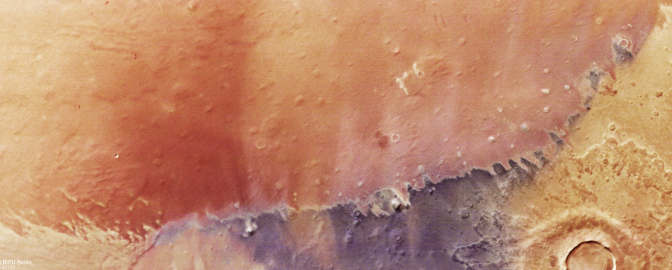How EELS could change the future of robotic exploration

Written by
Kate Howells
Public Education Specialist, The Planetary Society
August 8, 2024
When you picture a robot exploring the surface of another world, familiar images probably come to mind: a wheeled rover, maybe even a flying drone. You probably don’t imagine a snake-like robot wriggling its way across an alien landscape. Yet NASA’s EELS (Exobiology Extant Life Surveyor) project aims to prove that this is exactly the kind of robot you’d want to send to a new, unexplored world.
EELS was first designed with the challenges of exploring Saturn’s moon Enceladus in mind. Data from NASA’s Cassini spacecraft suggest that beneath the moon’s thick, icy crust is a huge ocean of liquid water, perhaps with conditions favorable to life. Around Enceladus’ south pole, enormous geysers of water shoot through cracks in the ice, hinting at the potential for a mission to access those oceans and search for signs of life.
Because Enceladus is unlike any place robotic explorers have ever been, it will require a different kind of robot from any we’ve used before — especially if that robot’s goal is to descend deep into a fissure to explore the waters below. And EELS is a very different kind of robot indeed.

How EELS will work
EELS is a snake-like, self-propelled robot made of multiple segments. It is currently in development and several prototype versions have been built, with some capabilities still undergoing testing.
Each segment of EELS has independently actuated counter-rotating screws that provide propulsion, traction, and grip. Because of its segmented design, EELS can take on various shape configurations to widely adapt its mode of propulsion to use whatever is best suited to the challenges of its terrain. EELS uses stereo cameras and lidar to create 3D maps of its surroundings, then uses artificial intelligence to make autonomous decisions about where and how to move through its environment.
Because of all of this adaptability, EELS is capable of exploring extremely challenging terrain in unknown environments. Its use of AI to autonomously make decisions also means it doesn’t have to rely on controllers on Earth, meaning the robotic explorer can make decisions in real-time instead of waiting for commands that take hours to reach it.
Because EELS is designed to study its environment as well as navigate through it, it has been modeled with several possible methods of collecting data or retrieving samples. One model involves a payload segment that would carry science instruments or even deploy a Cryoegg, a spherical, wireless sensor package designed to drop into subglacial water and take measurements. EELS may also wind up being designed to collect samples beneath the ice, crawl back to the surface, and return those samples to a lander. Current EELS prototypes are still focusing on locomotion, with data collection capabilities planned for future iterations of the robot.
Proving EELS as an Enceladus explorer
While a robot like EELS could be used to explore a variety of worlds, its target right now is Enceladus. The team’s main goal is for the robot to be able to explore the surface of Enceladus, find the best place to get into the ice, descend down one of these cracks adapting its shape and movement as it does so, and then reach the subsurface ocean and test for signs of life.
In September 2023, EELS proved its ability to handle the kind of environment it might encounter on Enceladus. The mission team conducted field tests at Athabasca Glacier in Alberta, Canada, where moulins (glacial crevasses) provide some of the best earthly analogs of Enceladus’ fissures.

The EELS 1.5 prototype was lowered into a moulin and extended its length to press against opposite sides of the crack, supporting its own weight. Then it lowered itself deeper into the moulin using its screw-like rotors, descending 1.5 meters (about 5 feet) fully autonomously.
Robotic Exploration 3.0
The team behind EELS believes that its autonomy and adaptability represent a paradigm shift in robotic exploration. Hiro Ono, EELS Principal Investigator, describes this as “Robotic Exploration 3.0.”
In the earliest days of spaceflight, “Robotic Exploration 1.0” involved a high cadence of trial-and-error missions as humans designed robots, sent them to other worlds, and learned what worked. “Robotic Exploration 2.0” involved incremental sophistication in a multi-mission campaign, such as NASA’s series of Mars rovers. In this paradigm, each rover’s design was based on lessons learned from the experiences of previous rovers. More importantly, the way each rover would navigate its environment was largely determined before it even launched from Earth. This model of exploration relies heavily on an extensive knowledge of the environment a robot is going to be exploring — an impossibility (or at least, an extreme impracticality) when it comes to extremely distant worlds like Enceladus that we cannot scout out in advance.
In “Robotic Exploration 3.0,” adaptive, intelligent robots learn about their environment as they go and use versatile modes of mobility to navigate even the most extreme terrains with minimal guidance from human operators on Earth. EELS’ adaptive AI means that it makes decisions about how to move around its environment based on its experiences, and its approach can evolve during a mission.

The robot might start its exploration of a new environment by performing a simple task such as raising its “head” to look around. It would then use data from that experience to inform how it would perform a more complex task, such as moving forward. If that way of moving doesn’t work well, it would try another kind of propulsion. Along the way, it would collect data about the conditions and what worked best. Eventually, it would have enough of a sophisticated understanding of how to navigate the terrain to be able to take on highly complex tasks.
Most importantly, EELS could employ this approach to develop a completely different strategy for navigating a different world. If it were sent to the sandy dunes of Titan, for example, it would learn to move very differently than it would on the ice fields of Enceladus. This adaptability means a robot like EELS could be sent to a number of different destinations. In a presentation at the 2024 Amazon MARS conference, Ono proposed that EELS could someday explore a Kuiper Belt Object, an interstellar object like ‘Oumuamua, or even an exoplanet.
Support our core enterprises
Your gift today will go far to help us close out the year strong and keep up our momentum in 2026.
Donate

 Explore Worlds
Explore Worlds Find Life
Find Life Defend Earth
Defend Earth

